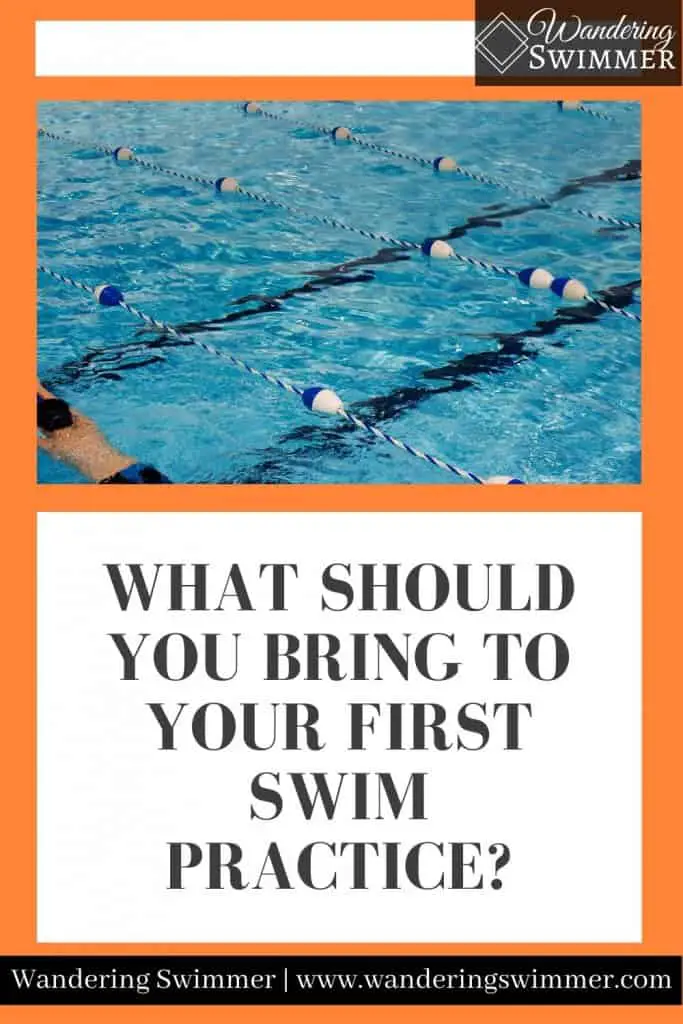If you just joined a swim team, congratulations! You might be facing several different emotions and questions as your first day gets closer. One question you might have in mind is what should I bring to my first swim practice?
More Content for You: 30 Words to Get You by at Swim Practice
The good news is that the answer isn’t as complicated as you think! And while some equipment might vary by team, the rest are things that you can count on needing.
Disclosure: This post may contain affiliate links, meaning I earn a small commission at no cost to you if you purchase something through one of my links. As an Amazon Associate, I earn from qualifying purchases. Please check out my disclosure page for more information.

Swimsuit
First and foremost, you should make sure you have your swimsuit!
Remember that not all swimsuits are made equal. You’ll want to have a swimsuit that’s designed for swimming laps. Certain brands will last longer as the fabric is made specifically for swim practices.
More Content for You: How to Prepare for Your First Swim Practice
Most of the swimsuits that you find in stores such as Wal-Mart or Target aren’t always the best for actual lap swimming or swim practice. They tend to cater to more leisure and fashion styles. It’s great if you plan to have fun at the pool!
But they’re not the best training suits.
We’ve found that the best suits are at dedicated swim shops or sports stores. These are geared towards training instead of leisure. And you’ll find that they’ll last a bit longer.
Some good brands to select from are:
Females should wear a one-piece suit and males should wear jammers or briefs.
One style of swim apparel to avoid for swim practice is board shorts and t-shirts. These add extra weight and drag while you’re swimming, making it much harder to swim.
While various swim shirts or rash guards exist, they’re not the best for practice. Instead, consider wearing them only for swim lessons, lap swimming, or for fun at the pool.
Related article: Answering Your Questions About Rash Guards and Swim Shirts
Goggles
Amidst everything that you have to bring, you’ll be surprised at how many new swimmers forget their goggles. And not just new swimmers at their first practice, but even those who swam for years!
Related articles:
Goggles help protect your eyes from chlorine and help you see better in the water. They are a must-have for your first swim practice. Not just your first practice, but every practice.
Make sure you bring a pair that you can wear for an extended period. Remember, your practices will last at least an hour. You don’t want to spend most of that time fighting with leaking goggles.
Some good pairs to consider are:
For those who wear glasses and/or contacts, you can also get prescription goggles from popular brands. It’s as easy as selecting your prescription when you place your order and then purchasing your goggles!
If your prescription is different per eye, you can buy two sets and switch out the eyepieces to match your needs.
It’s also worth noting that with time, your goggles will start to fog up. Regardless of the brand. They can even start fogging up the first time you use them! If this bothers you, try some anti-fog goggle spray before you get into the water.
Swim Cap
You should consider wearing a swim cap at your practice.
While they might be uncomfortable, the benefits they provide a swimmer far outweigh the disadvantages that come with them. When worn correctly, a swim cap can:
- Protect your hair
- Keeps hair from getting your face
- Eliminates drag
Related article: 6 Reasons to Wear a Swim Cap
Swim caps come in several different materials, each with their pros and cons. For swim practices, it’s best to go with either a latex or silicone swim cap. For more cap options and how to chose the best cap for you, check out our article ‘Your Quick Guide to Swim Caps‘.
- Latex: Latex caps are the cheapest caps you can find. They’re made of, you guessed it, latex, and run very thin. They can be uncomfortable due to their tight fit and how they often pull at the hair.
- Silicone: Silicone caps are made of a thicker, more durable material than latex caps. Due to the material, they usually last longer than latex. They also tend to be more comfortable. Both in terms of wear and for those who have hair, as it pulls less.
One thing to note is that a swim cap is not designed to keep your hair completely dry. Water will get into the cap and you’ll find that your hair can be damp when you take off your cap.
Towel
Don’t forget your towel! It’s easy to think about the things you’ll need in the water when you’re at practice. But it’s also easy to forget about what you need directly after practice 🙂
That being said, make sure you bring a towel. Or even two! If you don’t plan to change out of your suit on the way home, I recommend bringing a second towel for the car. This will help protect the interior of your car.
There’s no one specific towel required for swimming. However, I wouldn’t recommend a large beach towel, if only for the fact that they take up a ton of space in your swim bag. They can also take a bit longer to dry.
One option to consider is a shammy and/or a microfiber towel. These both run extremely thin and are space-saving small. As a bonus, they dry super quick.
Related article: 5 Reasons to Own a Shammy
Water Bottle
One myth of swimming is that swimmers don’t sweat because they’re in the water. Surprisingly, you do sweat!

Because of this, you need to make sure you bring a water bottle to your first swim practice. And every practice after it!
The best water bottles are ones with a flip-top lid, as they’re easy to drink from in between sets. Bottles with screw tops make it challenging to drink from when your rest is short. Get a reusable water bottle to help cut back on plastic!
And don’t just bring one, make sure you drink from it, too!
If you don’t like drinking water, consider options such as sports drinks or powder mixes to help add some flavor. Just ensure that it’s not loaded with sugar.
As a reminder, don’t forget to clean your water bottles at least weekly. And don’t share bottles at practice. This will help keep you healthy, especially during the flu season!
Recovery Snack
Swimming can work up an appetite. One thing to start getting into the habit of is bringing a snack for after practice. Preferably one that’s low in sugar and high in protein. Make sure to eat your snack directly after practice, as this will help your muscles recover better.
Protein bars and drinks are good options to consider for recovery after practice. Check their labels to make sure the sugar content isn’t too high. Or that sugar isn’t the first ingredient listed.
Start the habit with your first swim practice and remember to keep it going thereafter! Pack it in your bag the night before or when you’re getting your bag ready so you don’t forget.
Our favorite recovery snacks are some homemade protein cookies and an Adkins high-protein bar that’s easy to eat on the drive home.
Gear
Before starting or joining the team, you should ask your coach what equipment/gear you need. This will vary by team, but at minimum, you can expect to need the following:
If you’re required to bring other swimming gear, such as paddles and snorkels be sure to have those ready for your first swim practice. And not just the first day, but every practice.
One option to consider if you have a lot of gear is to store it in a gear bag. This is separate from a swim bag, as it’s used to store your pool-related gear. Gear bags are made of mesh, which allows your gear to dry out so it doesn’t develop mold.
Related article: 7 Things Every Swimmer Should Have
Some other gear related items that you should consider bringing are:
- Footwear (for around the pool and going back to your car)
- Change of clothes
- Tennis shoes for dryland
You might not need tennis shoes at your very first swim practice, but you’ll need them for sure when you go to the weight room. Be sure to ask your coach what day the team does dryland and have shoes for those days.
Swim Bag
Lastly, you’ll need something to put your towel, cap, goggles, and snack in! Most swimmers use a swim bag to store all their belongings. Not just for coming and going to practice, but also during practice!
You need a place to store your clothes while you’re in the water 🙂
While duffle or gym bags can work, swim bags usually have specific sections to help store wet items. They also have side pouches that perfectly hold goggle cases and caps.
Swim bags come in various sizes to fit your needs, from a small backpack to a larger bag for long meets.
Patience
We covered some physical items that you should bring for your first swim practice, but what about intangible things?
Patience is one of those intangible things. You’ll need to have and bring patience with you. Your first day of swim practice will be stressful when you’re new to the sport or team. But, you shouldn’t let that deter you.
More Content for You:
Exercise patience on your first day, if not your first week. It won’t take as long as you expect to get into the groove of your new team. However, you have to be patient with yourself and your teammates.
A little patience can go a long way!
Positive Outlook
In that same thought process, bring a positive outlook. Will your first day feel difficult? Probably! Can you get through it? ABSOLUTELY!!
It’s when you start letting that self-doubt, frustration, and negativity get the best of you that you start to fail. You’re starting something new. It’s okay if you’re not perfect right from the start.
Just remember to keep your head in the game and keep working. Don’t let yourself stop, falter, or lose sight of that positive energy. You might surprise yourself with how far you can go with a little positive energy.
Plus, positivity is infectious!
In Closing
The first day of anything new can cause anyone anxiety. But having an idea of what to bring and how to prepare can help ease some of those nerves.
When in doubt, talk to your coach before your first day to get an idea of what all you should bring. Or ask a teammate. They know best!
As always, to happy swimming!
Chevron
Bonus Content:
First Day of Swim Practice (And What to Expect): Your first day of swim practice can feel daunting. Knowing what to expect at swim practice can take away the unknown and set you up for success on day one!
Advice for Swim Practice Etiquette: Every swim team has practice etiquette that they follow. If you’re new to a swim team, we’ve compiled some swim practice etiquette to help get you started.

Want to Improve at the Pool?
Join swimmers and swim parents to receive my free newsletter and receive a free Swimming Glossary e-book as a thanks!
Every month you’ll receive tips and coaching to help you find success at the pool.